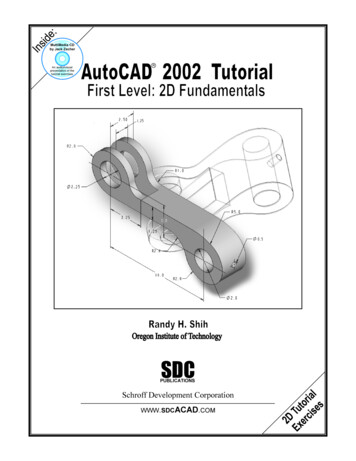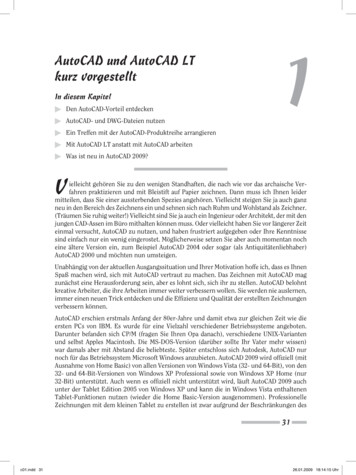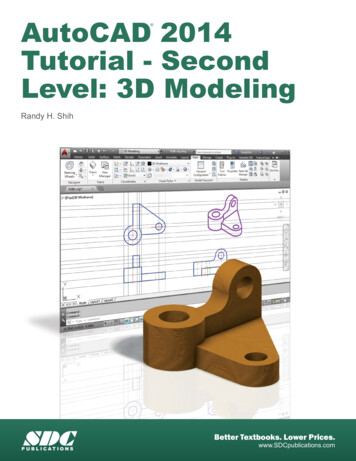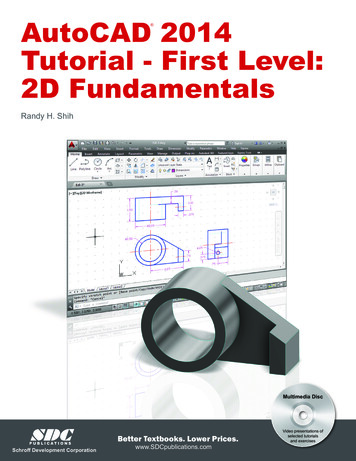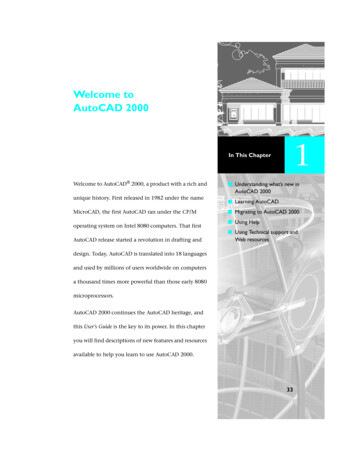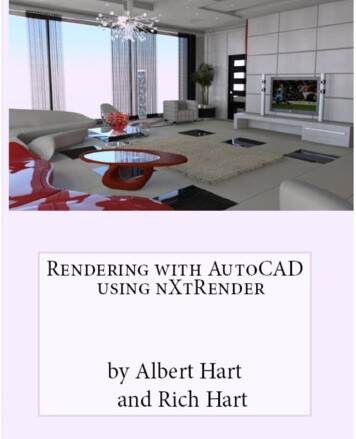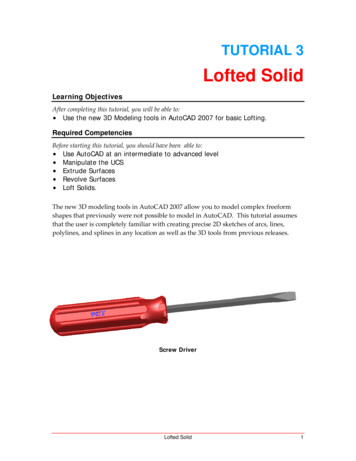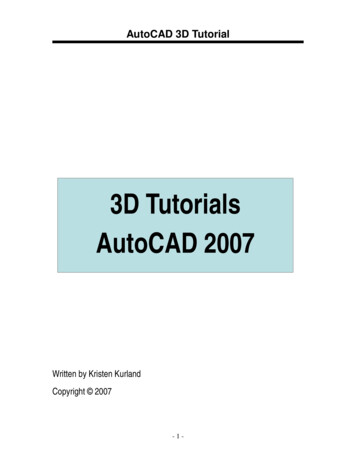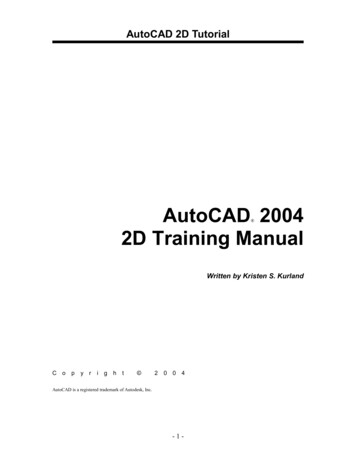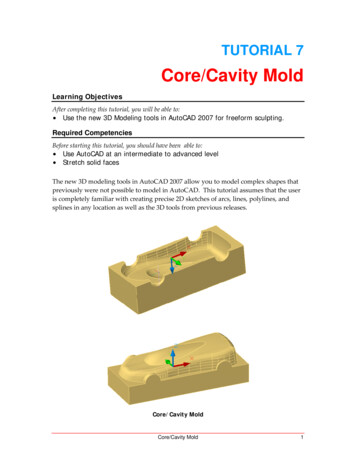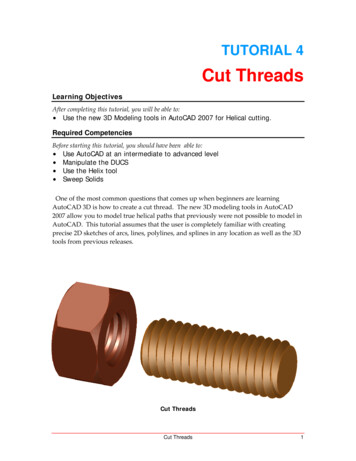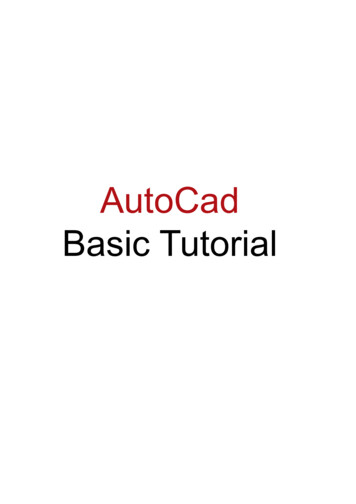
Transcription
AutoCadBasic Tutorial
Launching AutoCad1. Start2. 3D and CAD3. AutoCad
Typing CommandsTyping a CommandAll AutoCAD commands can be typed in at the command line. Many commands also have oneor two letter aliases that can also be typed as shortcuts to the commands.1. Type the desired command at the command prompt.Command : LINEor2. Type the command’s alias. Command: L3. Press ENTER/Space to end.4. Type an option at the command prompt.TIP: Many AutoCAD commands require you to press ENTER to complete the command. You know you are nolonger in an AutoCAD command when you see a blank command line.Reissuing the Last CommandThe last used AutoCAD command can be re-entered by one of the following three methodsof ENTER. The ENTER key on the keyboard will always act as ENTER, the SPACEBAR andRIGHT MOUSE will act as enter most of the time (exceptions include placing TEXT).1. Press the ENTER key on the keyboardor2. Press the Space bar on the keyboard.or3. Click the right mouse button.
Pointing Device (Mouse)AutoCAD uses either a mouse or digitizing tablet to select objects in a drawing.Left Mouse ButtonUsed to pick or select objects1. Click the left mouse button to select an object area in the drawing.2. Press ESC twice to deselect an object (or to cancel a command).Right Mouse ButtonUsed to enter a command, repeat last command, or access shortcut menus.1. Click the right mouse button.TIPS: SHIFT the right mouse button brings up the object snap menus. Various screen locations for the mouse brings up different menus. menus.
5.2 PANShifts the location of a view.1.ChooseView, Pan.or2.Clickthe Pan icon.or3.TypePAN from the command prompt.Command: PAN or PTIPS:-While in the PAN command, click with the right mouse button to see thefollowing menu.-Panning can also be done by using the window scroll bars
5.1 ZOOMIncreases or decreases the apparent size of objects in the current viewport1.ChooseView, Zoom.or2.Clicka Zoom icon.or3.TypeZOOM at the command prompt.Command: Zoom or Z4.TypeOne of the following zoom options:The following are basic zoom options:AllPlaces entire drawing (all visible layers) ondisplay at once. Forces a regeneration.ExtentsDisplays current drawing content as large as possible.PreviousRestores previous view.WindowDesignates rectangular area to be drawn as large aspossible.NumberMagnification relative to ZOOM All displayNumber XMagnification relative to current display (1X)CenterSpecifies center point and new display height.DynamicPermits you to pan a box representing the viewingscreen around the entire generated portion of thedrawing and enlarge or shrink it.TIPS:-While in the ZOOM command, click with the right mouse button to see themenu to the right.
2.2 Creating a New DrawingNEW CommandCreates a new drawing file.1.ChooseFile, New.or2.PressCTRL Nor3.Clickthe New icon.or4.TypeNEW at the Command prompt.Command: NEW5.ChooseOne of the options for creating a new drawing.6.ClickThe OK button.7.Savethe drawing as another name.TIP:New drawings can also be created from Template Files.
1.11 Undo and RedoReverses the last action.1.Choose Edit, Undo.or2.Click the Undo icon.or3.Press CTRL Z.4.Type U at the command prompt to undo the last command.Command: URedoReverses the effects of a single UNDO or U command.1.Choose Edit, Redo.or2.Click the Redo icon.or3.Type REDO at the command prompt to redo the last undo command.Command: REDOTIPS:-UNDO has no effect on some commands and system variables, includingthose that open, close, or save a window or a drawing, display information,change the graphics display, regenerate the drawing, or export the drawingin a different format.-REDO must immediately follow the U or UNDO command.
1.12 Function Keys and Accelerator Keys
2.1 Open Existing Drawings1.ChooseFile, OPEN.or2.PressCTRL O.or3.Clickthe OPEN icon.or4.TypeOPEN at the command prompt.Command: OPEN5.PressENTER6.Double Clickthe desired directory to find the drawing toopen.7.Clickthe drawing name to open.8.ClickThe OK button.TIP:-Preview shows a bitmap image of the drawing selected. This image is theview that was last saved in the drawing. It will not show a preview ofdrawings saved before R13 AutoCAD.
Quick SaveThe QSAVE command is equivalent to clicking Save on the File menu.If the drawing is named, AutoCAD saves the drawing using the file formatspecified on the Open and Save tab of the Options dialog box and does notrequest a file name. If the drawing is unnamed, AutoCAD displays the SaveDrawing As dialog box (see SAVEAS) and saves the drawing with the filename and format you specify.1.PressCTRL S.or2.Clickthe Save icon.or3.TypeQSAVE at the command prompt,Command:QSAVETIPS:Drawings can be saved as different versions of AutoCAD (e.g. R13, R14, R2000, etc.)AutoSave settings under Tools, Options
Useful Commands
7.1 Running Object SnapsAn object snap mode specifies a snap point at an exact location on anobject. OSNAP specifies running object snap modes, which remainactive until you turn them off.1.ChooseTools, Drafting Settings.or2.TypeDDOSNAP at the command promptCommand: DDOSNAPor3.ClickOSNAP on the Status Bar.4.Right Click the Object Snap TAB.5.Choosean object snap to turn ON/OFF from the dialogbox.
AutoCAD 2D TutorialUNITS Command 8.51.ChooseFormat, Units.or2.TypeDDUNITS at the command prompt.Command: DDUNITS or UN3.Choosea units and angle setting.4.Choosea precision setting.- 58 -
3.1 Line CommandCreates single straight line segments1.ChooseDraw, Line.or2.Clickthe Line icon.or3.TypeLINE from the command promptCommand: LINE or L4.PressENTER5.PickFrom point: (point)6.PickSpecify next point or [Close/Undo]:(point)7.PickSpecify next point or [Close/Undo]:(point)8.PressENTER to end line sequenceor9.TypeU to undo the last segmentTo point: U (undo)or10.TypeC to create a closed polygonTo point : C (close)TIPS: You can continue the previous line or arc by responding tothe From point: prompt with a space or ENTER. Choose the right mouse button for the line pop-up menu toappear while in the line command
AutoCAD 2D TutorialPline Command 15.1A polyline is a connected sequence of line segments created as a singleobject. You can create straight line segments, arc segments, or acombination of the two.1.ChooseDraw, Polyline.or2.Pickthe Pline icon.3.TypePLINE at the command promptCommand : PLINE or PL4.PickA point on the drawing to start the polylineFrom point:(select)5.TypeOne of the following optionsArc/Close/Halfwidth/Length/Undo/Width/ endpoint ofline :or6.PickA point to continue drawingArc/Close/Halfwidth/Length/Undo/Width/ endpoint ofline : (pick point)Polyline as one segment- 128 -
3.4 Orthogonal LinesControls lines from being drawn at various angles to straight lines. When thesnap grid is rotated, ortho mode rotates accordingly.1.PressFunction Key F8.or2.Double ClickORTHO from the Status Bar.or3.Line drawnwithORTHO ONPressCTRL L.Line drawnwithORTHOOFF
AutoCAD 2D TutorialRectangle 16.21.ChooseDraw, Rectangle.or2.Clickthe Rectangle icon.or3.TypeRectang at the command prompt Command:RECTANG Chamfer/Elevation/Fillet/Thickness/Width/ First corner :4.Pickfirst corner.5.Pickother corner or type coordinates (i.e. @4,2).- 137 -
3.6 CirclesCircle Command1.ChooseCircle, Center RadiusDraw, Circle.or2.Clickthe Circle icon.or3.TypeCIRCLE at the command prompt.Command: CIRCLE4.TypeCircle, Center DiameterOne of the following options:3P/2P/TTR/ center point :or5.PickA center point.6.TypeA radius or diameter.or7.PickA radius or diameterCircle, Tangent, Tangent RadiusDiameter/ radius :TIPS:- To create circles that are the same size, pressENTER when asked for the circle radius.- When selecting a circle with a pickbox, be sureto select the circumference of the circle.Circle, Tangent, Tangent, Tangent
3.7 Arc Command1.ChooseDraw, Arc.or2.Clickthe Arc icon.or3.TypeARC at the command promptCommand: ARC4.DrawOne of the arcs.TIPS:-Except for 3 point arcs, arcs are drawn in a COUNTERCLOCKWISEdirection.- While in the arc command, press the right mouse button to select thefollowing options for arcs:Arc Examples3 point arcStart ,center, chord lengthstart, center, endStart, end, radiusStart , center, included angleStart, end, direction
AutoCAD 2D TutorialSpline 16.3The SPLINE command creates a particular type of spline known as anonuniform rational B-spline (NURBS) curve. A NURBS curve produces asmooth curve between control points1.ChooseDraw, Spline.or2.Clickthe Spline icon.or3.TypeSPLINE at the command promptCommand: SPLINE4.PickA start point for the splineObject / Enter first point : (pick point)5.PickPoints until youare done drawing splinesEnter point:(pick points)6.PressEnter or close to complete the spline7.PickStarting tangent point for the splineEnter start tangent (pick point)8.PickEnding tangent point for the splineEnter end tangent: (pick point)- 138 -
Editing
AutoCAD 2D TutorialEditing Polylines 15.21.ChooseModify, Polyline.or2.Pickthe Pedit icon from the Modify II toolbar.3.TypePEDIT at the comma nd promptCommand: PEDIT4.PickPick a polyline to editSelect Polyline:(pick)5.TypeOne of the following options:Close/Join/ o/eXitPEDIT options:CloseCloses open polyline segmentsJoinConnects polylines, lines, and arcs to existing polylines.WidthChanges the width for all polyline segments.Fit curveCreates curved arc segments around pline vertices at thedirection you specify.Spline CurveCreates a curve through control points on a polyline.DecurveStraightens curved segments.Edit VertexDisplays the following Edit Vertex Options:Polyline width changeSplined Polyline- 130 -
AutoCAD 2D TutorialMove Command 10.11.ChooseModify, Move.or2.Clickthe Move icon.or3.TypeMOVE at the command promptCommand: MOVE or M4.PickObjects to moveSelect objects: (select)5.PickA point to move fromBase point or displacement: (pick point)6.PickA point to move toSecond point of displacement: (pick point)Circle before moveCircle after moveTIP:To move an object a specified distance, type a distance at the secondpoint of displacement prompt: @1 0- 74 -
AutoCAD 2D TutorialCopy Command 10.21.ChooseModify, Copy.or2.Clickthe Copy icon.or3.TypeCOPY at the command prompt.Command: COPY or CP4.PickObjects to copy.Select objects: (select)5.PickA point to move from.Base point or displacement/Multiple: (pick point).6.PickA point to copy to.Second point of displacement: (pick point)or7.TypeA point to copy to.Second point of displacement: @ 1 0Duplicate objects copiedMultiple objects copiedTIP: To copy many objects in the same copy command, type M for Multiple atthe “Base point or displacement/Multiple” option.- 75 -
AutoCAD 2D TutorialOffset Command 10.4Offset DistanceTo offset a specified distance:1.ChooseModify, Offset.or2.Choosethe Offset icon.or3.TypeOFFSET at the command prompt.Command: OFFSET or O4.TypeThe distance to offset.Offset distance or Through point : (number)5.6.PickPickThe object to offset.Select object to offset: (select object)A side to offset object to.Side to offset: (pick side)7.PickAnother object to offsetSelect object to offset: (pick side)or8.PressEnter to end the command.Offsetting objects by specifying a distance- 77 -
AutoCAD 2D TutorialExplode Command 15.41.ChooseModify,Explode.or2.Pickthe Explode icon.3.TypeEXPLODE at the command prompt.Command: EXPLODEor4.PickThe object to explode. Select objects: (pick)Polyline beforeexplodePolyline (line)after explode- 133 -
AutoCAD 2D TutorialEXTEND 10.51.ChooseModify, Extend.or2.Clickthe Extend icon.or3.TypeEXTEND at the command promptCommand: EXTENDSelect boundary edge(s).4.PickThe BOUNDARY edge to extend toSelect objects: (select)5.PressENTER to accept the boundary edgeSelect objects: (press enter)6.PickThe objects to extend Select object to extend / Project /Edge / Undo: Select an object, enteran option, or press enter : (select)7.PressENTER when you are done choosing objectsLines Extendedto an Arc(Arc is boundary edge)TIP:-Use the object selection option FENCE to choose multiple objects- 79 -
AutoCAD 2D TutorialStretch 13.21.ChooseModify, Stretch.or2.Clickthe Stretch icon.3.TypeSTRETCHat the command prompt.Command : STRETCH Selectobjects to stretchby window.4.TypeC to choose CROSSING windowSelect objects: C5.PickA first corner to stretch. First corner: (point)6.PickThe opposite corner to window the objects tostretch.Other corner: (point)7.PressENTER to accept objects to stretch.8.PickA base point to stretch from Base point:(point)- 114 -
AutoCAD 2D Tutorial9.PickA point to stretch to Newpoint: (point)or10.TypeA distance to stretch. New point: @1 0TIP:The Stretch command must use a CROSSING window or aCROSSINGPOLYGON window.- 115 -
AutoCAD 2D TutorialTRIM 10.6The TRIM command allows you to trim objects in a drawing so they endprecisely at a cutting edge defined by one or more other objects in thedrawing.1.ChooseModify, Trim.or2.Clickthe Trim icon.3.TypeTRIM at the command promptCommand: TRIMSelect cutting edge(s).4.PickThe CUTTING edge to extend toSelect objects: (select)5.PressENTER to accept the cutting edgeSelect objects: (press enter)6.PickObjects to trim Select object to trim / Project / Edge / Undo:Select an object, enter an option, or press enter7.PressENTER when you are done choosing objectsSelect object to trim/Undo: (press enter)Lines Trimmedto an Arc(Arc is cuttingedge)TIP: Hold the SHIFT key to interactively extend instead of trim.- 80 -
AutoCAD 2D TutorialBreak 13.11.ChooseModify, Break.or2.Clickthe Break icon.or3.TypeBREAK at the command prompt. Command: BREAK4.PickObject to break.Select object: (select one object)5.PickA second break point.Enter second point : (point)or6.TypeF to choose a different break pointEnter second point (or F for first point):(F)- 112 -
AutoCAD 2D TutorialMIRROR 10.71.ChooseModify, Mirror.or2.Clickthe Mirror icon.or3.TypeMIRROR at the command prompt.Command: MIRROR4.PickObjects to mirror.Select objects:(select)5.PickFirst point of mirror line: (point)6.PickSecond point: (point)7.TypeYes to delete the original objects andNo to keep them.Delete old objects? Y or NMirror Line- 82 -
AutoCAD 2D TutorialROTATE 10.91.ChooseModify, Rotate.or2.Clickthe Modify icon.or3.TypeROTATE at the command promptCommand : ROTATE4.PickObjects to rotate:Select objects:(select)5.PickA pivot point to rotate aroundBase point: (point)6.TypeA rotation angle Rotation angle /Reference:(number)or7.PickA rotation angle Rotation angle /Reference: (point)- 84 -
AutoCAD 2D TutorialSCALE 10.101.ChooseModify, Scale.or2.Clickthe Scale icon.or3.TypeSCALE at the command promptCommand: SCALESelect objects: (select objects)4.PickA pivot point to scale about Base point: (point)5.TypeA rotation angle Scale factor /Reference:(number)or6.PickA scale factor Scale factor /Reference:(point)Scale factor/Reference: (points)- 86 -
AutoCAD 2D TutorialText Command 11.1TextCreates a single-line text object1.TypeTEXT at the command promptCommand: TEXTor2.Pickthe Single Line Text icon from the Text Toolbar.3.PickA start pointJustify/Style/ Start Point : (point)or4.TypeJ to change the justification or S to change the textstyle.5.TypeA text heightHeight default : (type value or pick two points)6.TypeA rotation angleRotation angle default : (angle or point)7.TypeA text stringText: (type text string)8.Pressenter to exit the Text: prompt.DTEXT (Dynamic Text)Creates a single-line text object, showing the text dynamically on thescreen as it is entered.1.ChooseDraw, Text, Single Line Text.or2.TypeDTEXT at the command promptCommand : DTEXT3.Followthe steps 3-8 from above.- 89 -
Layers
AutoCAD 2D TutorialIntroduction to Layers and Layer Dialog Box12.11.ChooseFormat, Layer.or2.TypeLAYER at the command prompt.Command: LAYER (or LA)or3.Pickthe layers icon from the Layer Control boxon the object properties toolbar.AutoCAD 2005Layer Properties- 101 -
AutoCAD 2D TutorialLayer Options 12.2?MakeSetLists layers, with states, colors and linetypes.Creates a new layer and makes it current.Sets current layer.NewCreates new layers .ONTurns on specified layers.OFFTurns off specified layers.ColorAssigns color to specified layers.LtypeAssigns linetype to specified layers.FreezeCompletely ignores layers during regeneration.ThawUnfreezes specified layers Ltype.LockMakes a layer read only preventing entities from beingedited but available visual reference and osnap functions.UnlockPlaces a layer in read write mode and available for edits.PlotTurns a Layer On for PlottingNo PlotTurns a Layer Off for PlottingLWeightControls the line weight for each layerTIP:Layers can be set using the command line prompts for layers. To use this,type –LAYER or -LA at the command prompt1.TypeCommand: -LAYER or LA2.TypeOne of the following layer aw:- 102 -
AutoCAD 2D TutorialLayer Shortcuts 12.3Changing the Layer of an Object1.ClickOnce on the object to change.2.Selectthe desired layer from the Layer Control Boxdropdown.AutoCAD will move the object to the newlayer.Select layerSelect object first- 103 -
Colours LineWeights
AutoCAD 2D TutorialColor Command 12.61.ChooseFormat, Color.or2.TypeDDCOLOR at the command prompt.Command: DDCOLOR or COLor3.ChooseColor on the Object Properties toolbar and thenselect a color from the list or select Other to displaythe Select Color dialog box.TIP:These settings ignore the current layer settings for color.By LayerIf you enter bylayer, new objects assume the color of the layer upon whichthey are drawn.By BlockIf you enter byblock, AutoCAD draws new objects in the default color (whiteor black, depending on your configuration) until they are grouped into a block.When the block is inserted in the drawing, the objects in the bloc k inherit thecurrent setting of the COLOR command.- 107 -
AutoCAD 2D TutorialLinetypes 12.7Loading and Changing Linetypes1.ChooseFormat, Linetype.or2.TypeDDLTYPE at the command prompt.Command:DDLTYPE or LT3.ChooseLoad. to see a list of available linetypes.4.Choosethe desired linetype to assign.5.ClickOK.- 108 -
AutoCAD 2D TutorialLineweights 12.8Loading and Changing Lineweights1.ChooseFormat, Lineweight.or2.TypeLINEWEIGHT at the command prompt.Command: LINEWEIGHT or LWEIGHTor4.Picka lineweight to make current from the ObjectProperties menu.TIPS:-Lineweights can also be assigned to layers.-The Display Lineweights feature can be turned on/off o n the status bar toshow or not show lineweights in the drawing, thus making regenerationsfaster.-Lineweights are displayed using a pixel width in proportion to the realworld unit value at which they plot. If you are using a high-resolutionmonitor, you can adjust the lineweight display scale to better displaydifferent lineweight widths.- 109 -
AutoCAD 2D TutorialObject Properties 12.91.ChooseModify, Properties.or2.Clickthe Properties icon.or3.TypeDDCHPROP or DDMODIFY at the command prompt.Command: DDCHPROP (CH) orDDMODIFY (MO)4.PickObjects whose properties you want to changePick a window for DDCHPROP, single objectfor DDMODIFY.Select objects:(select)5.PressENTER to accept objects.Select objects: (press enter)6.ChooseOne of the following properties to change.- 110 -
Other UsefulFunctions
AutoCAD 2D TutorialBHATCH Command 17.11.ChooseDraw, Hatch.or2.Clickthe Hatchicon.or3.TypeBHATCH at the command promptCommand: BHATCH- 152 -
AutoCAD 2D TutorialMeasuring Distances 8.21.ChooseTools, Inquiry, Distance.or2.Clickthe Distance icon from the Inquiry Toolbar.or3.TypeDIST at the command promptCommand: DIST4.PickThe first point to measure fromFirst point: pick point5.PickThe second point to measure toSecond point: pick pointDistance Between Circle CentersTIP:Be sure to use Object Snaps with the MEASURE command.- 55 -
AutoCAD 2D TutorialLinear Dimensions 26.11.ChooseDimension, Linear.or2.Clickthe Linear Dimension command from the toolbar.or3.TypeDIM at the command prompt.Command: DIMDim: HOR or VER- 223 -
AutoCAD 2D TutorialAligned Dimensions 26.21.ChooseDimension, Aligned.or2.Clickthe Aligned Dimension command from thetoolbar.or3.TypeDIM at the command prompt.Command: DIMDim: ALIGNED- 224 -
AutoCAD 2D TutorialRadial Dimensions 26.31 . ChooseDimension, Radius or Diameter.or2 . Clickthe Radial Dimensions command from thetoolbar.or3 . TypeDIM at the command prompt.Command: DIMDim: RADIUS or DIAMETER- 225 -
AutoCAD 2D TutorialCalculating Areas 8.31.ChooseTools, Inquiry, Area.or2.Clickthe Area icon.or3.TypeAREA at the command promptCommand: AREA4.PickThe first point for area calculation First point /Object/Add/Subtract: pick5.PickNext point: pick6.PickNext point: pick7.PressENTER when you are finished choosing points.Area of RectangleObjectAllows user to pick an object to calculatearea (circle or polyline).AddAdds separate areas for a total area calculationSubtractSubtracts areas from each other.TIPS:Be sure to use Object Snaps with the MEASURE commandTo subtract an area, you must first be in “add” mode to add the first area.- 56 -
AutoCAD 2D TutorialPlot Settings1.Choosethe Plot Settings tab.2.Choosethe appropriate paper size based on thechosen plotter.3.Choosethe paper units (inches or mm).4.Choosethe drawing orientation (Portrait, Landscape,Upside down).5.Choosethe plotting area.6.Choosethe plot scale.7.Chooseplot to center or specify an x or y offset.8.ClickOK.- 65 -
1.13 On-Line Help1.Choose Help, AutoCAD Help.or2.Click the Help icon.or3.Type HELP at the command promptCommand: HELPor4.Press Function Key F1
If the drawing is named, AutoCAD saves the drawing using the file format specified on the Open and Save tab of the Options dialog box and does not request a file name. If the drawing is unnamed, AutoCAD displays the Save Drawing As dialog box (see SAVEAS) and saves the drawing with the fi
